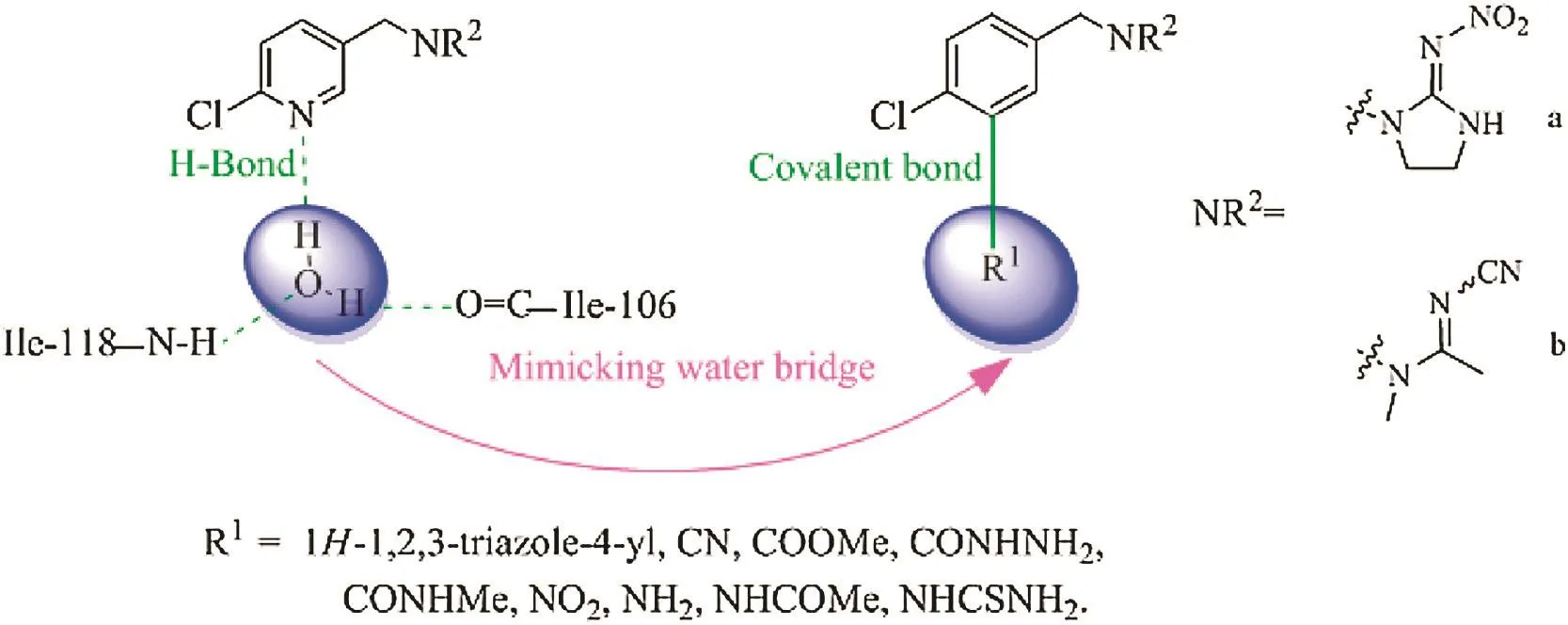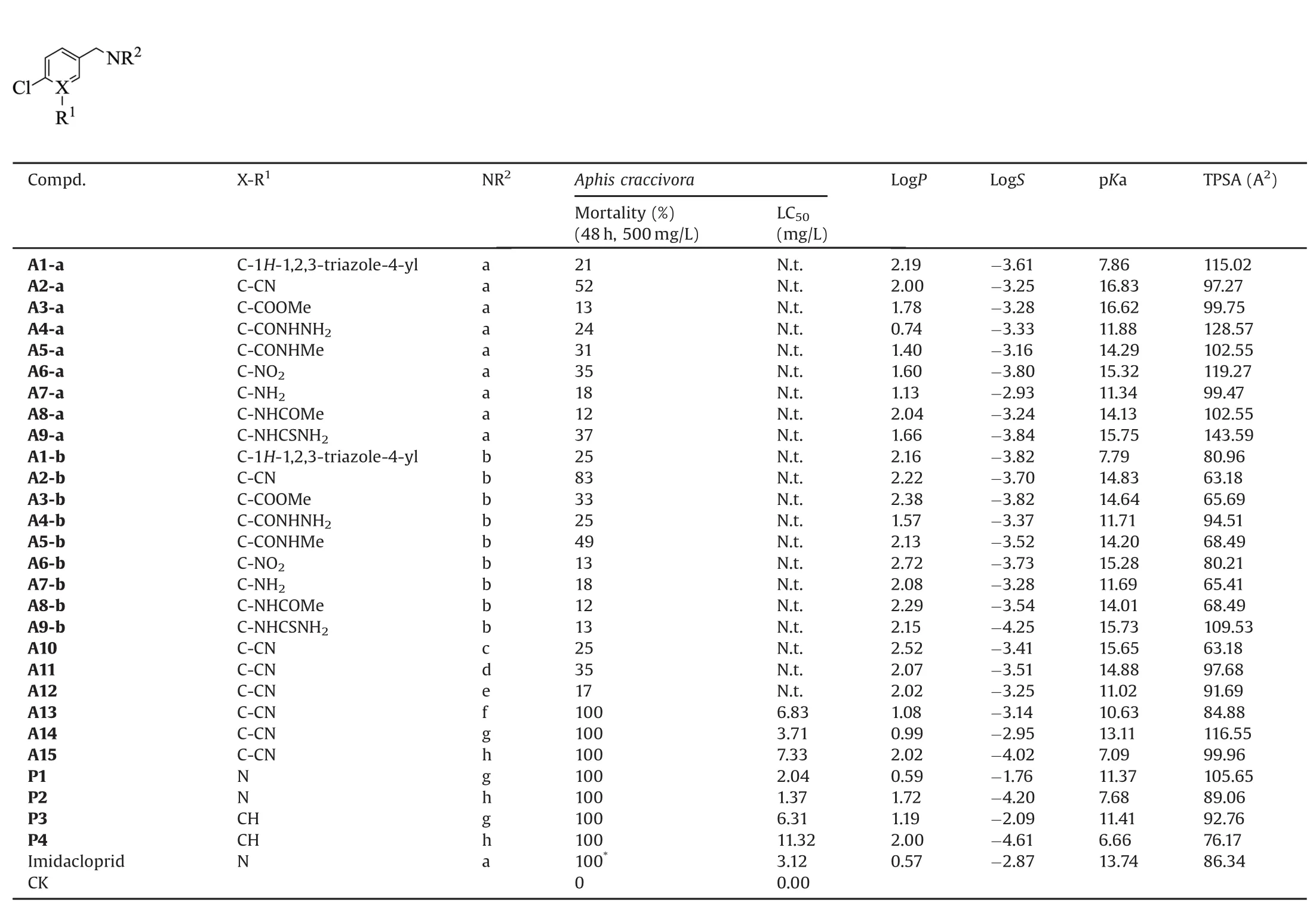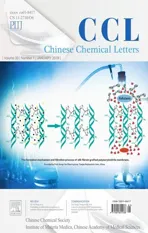Water bridges are essential to neonicotinoids:Insights from synthesis,bioassay and molecular modelling studies
2019-02-15ChengchunZhuGunglongLiKeyXioXushengShoJigoChengZhongLi
Chengchun Zhu,Gunglong Li,Key Xio,Xusheng Sho,Jigo Cheng,*,Zhong Li,b
a Shanghai Key Laboratory of Chemical Biology,School of Pharmacy,East China University of Science and Technology,Shanghai200237,China
b Shanghai Collaborative Innovation Center for Biomanufacturing Technology,Shanghai200237,China
Keywords:Neonicotinoids Water bridge Insecticidal activity Cyano group Molecular design
ABSTRACT Water-bridged H-bonds have been observed in many casesof ligand-receptor recognitions.To explore the roles of w ater bridges in the binding of neonicotinoids with receptors,twenty-four neonicotinoid compounds with nine fragments,including 1H-1,2,3-triazole,CN,COOMe,CONHNH2,CONHMe,NO2,NH2,NHCOMe and NHCSNH2 were synthesized and evaluated,of which,compounds with cyano group showed the best activities against Aphiscraccivora.Accordingly,the cyano group is the optimal fragment mimicking the water bridge.Tw o cyano-substituted[38_TD DIFF]cis-nitromethylene compounds display good insecticidal activities,w hereas the LC50 values are lower than those of their corresponding prototypes.Docking study showed that the cyano group acts only as H-bond acceptor,while the w ater bridge can act as both donor and acceptor.It revealed that the w ater bridge might be stable in the active site and was not suitable to be replaced by other groups.The fi ndings illustrated that the w ater bridge isnecessary for high insecticidal activitiesof neonicotinoids,which should be also helpful in better understanding the binding mode of neonicotinoids.
Water molecules in ligand binding pockets can bridge interactions between ligands and proteins through H-bonds,namely w ater-bridged H-bonds.Water bridges have been reported in numerous protein-ligand complex structures,and observed playing crucial roles in many cases of ligand-receptor recognitions[1–3].If a w ater bridge is fl exible in the binding pocket,it can be mimicked or replaced by other fragments.In drug discovery and optimization,such a strategy has been fully applied to get novel ligand scaffolds or improve binding af fi nities[4–7].For example,by replacing the role of water bridge,a number of pharmaceutical instances have been successfully achieved in lead optimization of EGFR[8,9],HIV-1 protease[10],etc.
In the cases of pesticides,w ater-bridged H-bonds also played key roles in the binding of insect nicotinic acetylcholine receptors(n ACh Rs)with neonicotinoids[11–14].Neonicotinoids were agonists of insect n ACh Rs[14,15],which occupied the largest insecticides market share of the w orld due to their excellent w idespectrum insecticidal activity and safety to mammals[16–18],and gained continuous research concern[19–22].In crystal structures of neonicotinoids with acetylcholine binding proteins(ACh BP),good surrogates for the extracellular domain of n ACh Rs,a w ater molecule was captured next to the pyridine/thiazole nitrogen atom of neonicotinoids in the binding pocket,which bridged crucial H-bonding network with the relevant surrounding residues[23,24].The pyridine/thiazole nitrogen atom served as H-bond acceptor in the binding pocket(Fig.1),w hose role could also be replaced by a fl uorine or a carbonyl oxygen of alkyl substituents in neonicotinoid analogues[11].QSARstudy revealed that the insecticidal activities of neonicotinoids were deeply correlated with the w ater-bridged H-bonds abilities[12].When the w ater-bridged H-bonds were broken in neonicotinoids N-oxide analogues,the insecticidal activities w ould be weak[13].
Although w ater-bridged H-bonds are reported in the recognition between neonicotinoids and n ACh Rs,few studies are focused on the w ater bridge itself.The detailed roles of w ater bridges on neonicotinoids are still open questions.It is still unknow n w hether the w ater bridge could be replaced by other structure fragments in pesticide molecular design.In this work,nine structure fragments that may mimic the roles of w ater molecule,including 1H-1,2,3-triazole,CN,COOMe,CONHNH2,CONHMe,NO2,NH2,NHCOMe and NHCSNH2were selected to occupy the binding site of w ater bridge,and then twenty-four neonicotinoid compounds were designed,synthesized,bioassayed and modeled to capture the detailed roles of w ater bridge.

Schem e 1.Synthesis route of cyano-substituted compounds A2-a and A2-b.
The synthesisof target compounds A1-a and A1-b wasshow n in Scheme S1 in Supporting information.The compound 2 was obtained in 80%yield from commercially available compound 1 as described in the literature[25].Intermediate 3 was obtained in 65%yield through deoxidation of compound 2,then was subjected to a Sonogashira coupling reaction and desilylation to provide compound 4 in 91%yield.Conversion of compound 4 to compounds6-a and 6-b was accomplished through chlorination and then aminolysis with relevant key intermediates a and b respectively.Lastly,the triazole substituted compounds A1-a and A1-b were gained by a modified Click reaction with excellent yields.
The synthesis of target compounds A2-a,A2-b was show n in Scheme 1.Intermediate 8 was obtained in 80%yield from compound 7 through a palladium-catalyzed ortho-halogenation.Based on compound 8,the target compounds were readily obtained through tw o steps involving a bromination reaction and a substitution reaction.
The synthesis route of target compounds A3-a,A3-b,A4-a,A4-b,A5-a and A5-b was show n in Scheme S2 in Supporting information,and synthesis of target compounds A6-a,A6-b,A7-a,A7-b,A8-a,A8-b,A8-b,A9-a and A9-b were show n in Scheme S3 in Supporting information.
The synthesis of target compounds A10[39_TD DIFF]?A15 were depicted in Scheme 2.Compounds A10[39_TD DIFF]?A13 were gained through the similar routes with previous compounds A2-a and A2-b.Compounds A14 and A15 were prepared according to the procedures in our previous studies[26,27].Compound A14 containing dihydroxysubstituted pyrrole fused ring was generated by treatment A13 with methylglyoxal.Conjugated diene compound A15 was afforded Stirring the mixture of intermediate A13 and furfural in the presence of a catalyst amount of hydrogen chloride gas.Compounds P1[26]and P2[27]have been reported in our previous studies,which were also generated in this work for comparison.P3 and P4 were synthesized according to the procedures of P1[26]and P2[27],respectively.

Fig.1.Design strategy of neonicotinoid derivatives by mimicking w ater bridge.
Then insecticidal activities against Aphis craccivora of all compounds were evaluated by leaf-dip method(Supporting information).Compounds A2-a and A2-b with cyano group showed the best insecticidal activities as compared with the other compounds.The cyano group has been also successfully used in rational design of inhibitors of scytalone dehydratase[28],EGFR kinase[29]and p38a MAPkinase[30],through displacing the key w ater molecule in active sites.Accordingly,the cyano group was considered as the optimal fragment that could well mimic the role of w ater bridge and was chosen in further structure derivations.
Six cyano-substituted compounds A10[39_TD DIFF]?A15 with different scaffolds were synthesized and bioassayed.Insecticidal activities of compounds A13[39_TD DIFF]?A15 exhibited 100%mortality at 500[40_TD DIFF]mg/L against cow pea aphids.Further bioassay showed that the LC50values of tw o cis-nitromethylene compounds A14 and A15 were 3.71[41_TD DIFF]mg/Land 7.33 mg/L,respectively,which were similar to that of imidacloprid(3.12 mg/L).Compounds A14 and A15 showed relative low insecticidal activities w hen compared with their corresponding chlorine pyridine prototypes P1(2.04[42_TD DIFF]mg/L)and P2(1.37 mg/L),respectively.In addition,A14 and A15 displayed stronger insecticidal activities than the phenyl structures without cyano substitution P3(6.31mg/L)and P4(11.32 mg/L),respectively.It indicated that the cyano substitution could contribute to the insecticidal activities,while the contribution was not as large as a pyridine ring.
Physical-chemical properties(logP,log S,p K a and TPSA)of all compounds were calculated(methods were show n in Supporting information)and then analyzed between the new cyano-substituted compounds versus imidacloprid.As show n in Table 1,the calculated logP,log S,p K a and TPSA values of new compounds are similar to those of their prototypes without cyano group(P1–P4).Accordingly,the difference in insecticidal activities could not be resulted only from the pesticide-like properties.
Docking studies were performed on compounds A2-a and A14 with Ac-ACh BPto illustrate the difference of insecticidal activities and detailed interactions between compounds and target(method was show n in Supporting information).As displayed in Fig.2,a N??H???31F]N H-bond,instead of the water bridged H-bond network,was observed between residue Ile-118 and the cyano groups of A2-a and A14,respectively.The binding pose of A2-a was very similar to imidacloprid and aligned well with imidacloprid(Fig.2c).In the crystal structures of imidacloprid with ACh BP,the w ater molecule could act as both donor and acceptor,and bridged tw o H-bonds with Ile-106 and Ile-118,respectively[23,24].Although the insecticidal activities indicated that the cyano group was the optimal group mimicking the w ater bridge among all nine tested fragments,it could act only as H-bond acceptor and formed a single H-bond with target,which might be one reason w hy the new cyano-substituted compounds displayed relative low insecticidal activities w hen compared with their corresponding leads.

Scheme 2.Synthesis route of cyan-substituted compounds.

Table 1 Physicochemical property and insecticidal activities of the target compounds and imidacloprid against cow pea aphids(Aphis craccivora).
On the other hand,the fragments 1H-1,2,3-triazole,CONHNH2,CONHMe,NHCSNH2and NHCOMe could act both as H-bond donor and acceptor,however,they were larger than the cyano in size.The weak activitiesof such fragment-substituted compoundsindicated that the active w ater site might be small in volume.In the complex crystal structure of ACh BP-imidacloprid,the w ater bridge located in a deep inner site of the binding pocket[23,24],implying that the w ater site was difficult to be occupied by other groups,even by the cyano group.It illustrated that the w ater bridge was essential for high insecticidal activities of neonicotinoids.

Fig.2.The docking poses of compounds within Ac-AChBP.The binding poses of A2-a(a),A14(b),and molecular alignment diagram of A2-a and imidacloprid(c).
In summary,to explore the key roles of w ater bridges in neonicotinoids recognition with receptor,nine fragments including 1H-1,2,3-triazole,CN,COOMe,CONHNH2,CONHMe,NO2,NH2,NHCOMe and NHCSNH2were introduced into the molecular design of neonicotinoids,and then twenty-four neonicotinoid compounds were synthesized,bioassayed and evaluated.The cyano-substituted compounds showed better insecticidal activities than other fragment-substituted compounds,thus the cyano group was considered as the optimal fragment mimicking w ater bridge.Although,the cyano-substituted compounds displayed similar pesticide-like properties and binding poses with their corresponding prototype structures,they showed relative weak insecticidal activities.It revealed that the w ater bridge might be stable in the active site and was difficult to replace by other groups,which illustrated again the signi fi cance of w ater-bridged H-bonds in the recognition of neonicotinoids with insect n ACh Rs.
Acknow ledgments
We thank for the fi nancial supports from the National Natural Science Foundation of China(Nos.21572059,21172070),Innovation Program of Shanghai Municipal Education Commission(No.201701070002E00037),and the Fundamental Research Funds for the Central Universities.
App endix A.Supp lem entary data
Supplementary material related to this article can be found,in the online version,at doi:https://doi.org/10.1016/j.cclet.2018.05.013.
杂志排行
Chinese Chemical Letters的其它文章
- Information for authors
- A one-pot protocol for copper-mediated azide–alkyne cycloaddition using alkenyl tri fl ate precursors
- One-pot synthesis of tetrahydroindoles via a copper catalyzed N-alkynation/[4+2]cycloaddition cascade
- Gram-scale preparation of dialkylideneacetones through Ca(OH)2-catalyzed Claisen-Schmidt condensation in dilute aqueous EtOH
- Tetra-phthalimide end-fused bi fl uorenylidene:Synthesis and characterization
- Novel dual inhibitors against FP-2 and PfDHFRas potential antimalarial agents:Design,synthesis and biological evaluation
